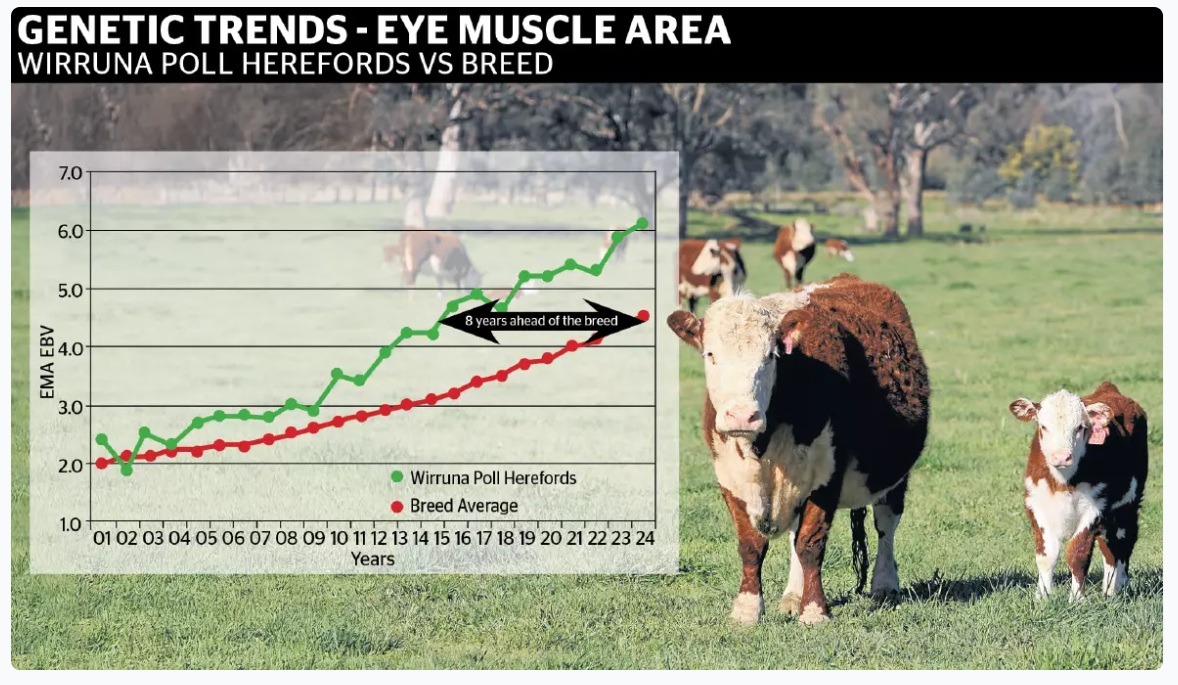Wirruna Muscle Article-The Land – CLICK LINK
HIGH levels of muscling are helping Wirruna Poll Herefords clients meet premium markets with exceptional carcase attributes.
The Holbrook, NSW-based stud is well established as the highest marbling Hereford herd in Australia, but it’s also working on improving overall muscle in its herd.
Stud principal Ian Locke said, while there was a way to go before extra muscling in British breeds would greatly impact herd production traits, there were big gains to be made.
“It is hard to find negatives to breeding for higher levels of marbling,” Mr Locke said.
“High levels of muscling, however, can draw mixed responses.
“Fundamentally, we are in the beef industry, and meat is muscle, and muscle is meat. Selection for muscle results in higher yielding cattle, and these are more attractive to meat processors, and in turn, add economic benefit to the producer and through the beef chain.”
Mr Locke said the introduction of heavily muscled European cattle breeds into Australia led to negative perceptions of increased muscling due to associated issues like calving difficulties, poor fertility, low fat levels, and large frame sizes.
“These problems, though partly breed-specific, were often wrongly blamed on muscling itself. As a result, many Australian producers have avoided selecting for muscle in breeding females, fearing it would negatively impact fertility, calving ease, and survival in tough pastoral conditions.”
The Wirruna herd has led the charge since the 1990s, incorporating carcase scanning and working closely with meat scientists.
The stud has contributed to key industry research initiatives, including the Beef CRC, leading to the development of the Meat Standards Australia (MSA) grading system.
It continues to be involved with projects, including the development of a mature cow body condition estimated breeding value (EBV).
“These efforts confirmed carcase traits to be core to our breeding goals for the Wirruna herd,” Mr Locke said.
“Muscling is one of the most important economic traits to ingrain in your genetics.
“Not only do animals with more muscling weigh heavier and generate more revenue, but muscling is critical in an animal’s ability to store energy.
“It’s a win-win through boosting on-farm and beef supply chain profitability and sustainability of a maternally efficient cow herd.”
Higher visible muscling has been shown to increase dressing percentage and saleable meat yield at slaughter.
Work by Peter McGilchrist, associate professor of meat science at the University of New England, determined that increased muscularity in beef cattle was strongly associated with a reduction in dark cutting.
“Thereby contributing to greater compliance with MSA requirements,” Mr Locke said.
“Research work by the late Bill McKeirnan at Glen Innes research station shows that selection for increased visual muscle score in British breed cows resulted in changes in body compositional traits, but had no effect on the maternal performance, nor on growth rates of progeny under average to good nutritional conditions.
“Furthermore, the high muscle line had the least calving problems as heifers.”
Breeding for improved muscle involves both utilising the eye muscle area (EMA) EBV and visual assessment of the animal’s muscle score.
“The correlation between muscle score and EMA is only moderate (53-56pc) and EMA is moderately heritable (40pc),” Mr Locke said.
“Nevertheless, a selection focus by driving EMA does improve herd muscle in the long term.”
Wirruna has been a breed leader for muscling for many years.

According to the June 2025 Hereford Breedplan, Wirruna prefix animals now represent 30 per cent of the top 100 animals in the Hereford breed for the EMA EBV, including some of the top performing animals. Picture supplied
The 2023-drop calves averaged in the top 15pc of the breed for muscle.
“This is eight years ahead of the average EMA for the breed,” Mr Locke said.
“This has been achieved in a balanced trait selection approach, not at the detriment of other important cattle performance traits.”
Wirruna uses index-based genetic selection that includes all the traits, such as cow fertility and beef quality traits, to ensure reproductive performance and beef quality is maintained during continued selection for higher levels of muscling.
Carcase scanning the whole herd – both females and males – to identify variation, along with the introduction of full herd genomics, has been key to the stud’s success.
“Being able to identify and select higher carcase merit genetics, both maternal and paternal, and being consistent with the breeding objective, has resulted in our continual improvement in carcase traits.”
The growing reputation of Wirruna genetics for superior carcase is gathering traction, particularly in grass-fed premium markets.
“The easy finishing, mid-maturity pattern cattle, combined with the high merit carcase attributes, are seeing improved MSA performance on clients’ kill sheets,” Mr Locke said.
“In January this year, the Wald family of Condobolin, NSW, supplied Wirruna-blood steers to the Teys Grasslands program.
“They averaged in the top 10pc of all MSA-graded cattle, with 70 of 90 animals achieving the highest grading groups.
“The cattle consistently recorded marble scores of two to four with low ossification, demonstrating the natural carcase advantage of the Hereford breed when combined with Wirruna’s genetic strength.”
Running a self-replacing 350-head Poll Hereford herd alongside their Tullinga Dorper stud and a commercial flock of 3000 ewes, Hamish and Penny Wald, with children Alex and Callum, are focused on supplying high quality beef and understand the role of genetics to unlock exceptional returns in the premium grass-fed beef market.
“Our cattle are finishing on grass with no need for a feedlot,” Mr Wald said.
“The efficiency and fertility bred into Wirruna genetics means they thrive under our low-input system.”
The Walds prioritise fertility, conformation, and temperament in their breeding decisions. They’ve sourced Wirruna bulls for the past 15 years.
“Even at the commercial end of the bull offering, the quality and data depth are consistent.”
Wirruna sells about 200 bulls each year, to commercial producers in all states of Australia.
On offer in the stud’s August 27 sale at Spring Valley, Holbrook are 58 bulls & 20 PTIC Heifers.